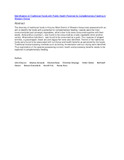| dc.contributor.author | Kinyuru, John | |
| dc.contributor.author | Konyole, Silvenus | |
| dc.contributor.author | Kenji, Glaston | |
| dc.contributor.author | Onyango, Christine | |
| dc.contributor.author | Owino, Victor | |
| dc.contributor.author | Owuor, Bethwell | |
| dc.contributor.author | Estambale, Benson | |
| dc.contributor.author | Friis, Henrik | |
| dc.contributor.author | Roos, Nanna | |
| dc.date.accessioned | 2021-06-01T15:27:30Z | |
| dc.date.available | 2021-06-01T15:27:30Z | |
| dc.date.issued | 2012-04 | |
| dc.identifier.uri | https://doi.org/10.5539/jfr.v1n2p148 | |
| dc.identifier.uri | http://www.ccsenet.org/journal/index.php/jfr/article/view/14730 | |
| dc.identifier.uri | http://r-library.mmust.ac.ke/123456789/1555 | |
| dc.description.abstract | The diversity of traditional foods in Kisumu West District of Western Kenya was assessed with an aim to identify the foods with a potential for complementary feeding. Leaves were the most consumed plant part amongst vegetables, while a few fruits were consumed together with their seeds. Amaranthus cruentus L. was found to be consumed as a leafy vegetable while another variety, Amaranthus hybridus L. was found to be consumed as a grain. Four species of winged termites, a grasshopper, black ant and dagaa fish were also identified. Twelve of the traditional foods were found to be associated with nutritional and health benefits as perceived by the locals. Traditional food processing methods such as boiling, fermentation and sun drying were identified. Thus exploitation of the species possessing nutrient, health and processing benefits needs to be explored in complementary feeding. | en_US |
| dc.language.iso | en | en_US |
| dc.publisher | Journal of Food Research | en_US |
| dc.subject | Traditional Foods, Public Health Potential, Complementary Feeding | en_US |
| dc.title | Identification of Traditional Foods with Public Health Potential for Complementary Feeding in Western Kenya | en_US |
| dc.type | Article | en_US |

